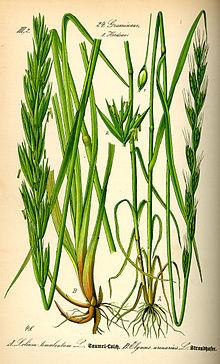- Lolium temulentum
-
Lolium temulentum 
Scientific classification Kingdom: Plantae (unranked): Angiosperms (unranked): Monocots (unranked): Commelinids Order: Poales Family: Poaceae Genus: Lolium Species: L. temulentum Binomial name Lolium temulentum
L.Lolium temulentum, typically known as darnel, poison darnel or cockle, is an annual plant that forms part of the Poaceae family and part of the Lolium genus. The plant stem can grow up to one meter tall, with inflorescence in the ears and purple grain. It has a global distribution.
Growth
Darnel usually grows in the same production zones as wheat and is considered a weed. The similarity between these two plants is so extensive that in some regions, cockle is referred to as "false wheat".[1] It bears a close resemblance to wheat until the ear appears. The ears on the real wheat are so heavy it makes the entire plant droop downward, but L. temulentum, whose ears are light, stands up straight. The wheat will also appear brown when ripe, whereas the darnel is black.[2] When the Lolium matures, the spikelets turn edgeways to the rachis, where the wheat spikelets remain as they grew previously.
The darnel can be infected by an endophytic fungus of the genus Neotyphodium, and the endophyte-produced, insecticidal loline alkaloids were first isolated from this plant.[3] It parasitizes wheat fields. The French word for darnel is ivraie (from Latin ebriacus, intoxicated), which expresses that weed's characteristic of making one feel poisoned with drunkenness, and can cause death. This characteristic is also alluded to in the scientific name (Latin temulentus = drunk).
Etymology
The plant is mentioned in Horace's Satire 2.6 (eaten by the Country mouse while he serves his guest fancier foods) and in the Parable of the Tares in the Gospel of Matthew:
Let both grow together until the harvest: and in the time of harvest I will say to the reapers, Gather ye together first the tares, and bind them in bundles to burn them: but gather the wheat into my barn.
Darnel is also mentioned as a weed in Shakespeare's King Lear.[4] and is one of the many ingredients in Mithradate, which is supposed to have been used by Mithridates VI on a daily basis to render him immune to poisoning.
Footnotes
- ^ Craig S. Keener, The Gospel of Matthew: A Socio-Rhetorical Commentary, Wm. B. Eerdmans Publishing, 2009 p.387
- ^ Heinrich W.Guggenheimer, The Jerusalem Talmud,Vol. 1, Part 3, Walter de Gruyter, 2000 p.5
- ^ Schardl CL, Grossman RB, Nagabhyru P, Faulkner JR, Mallik UP (2007). "Loline alkaloids: currencies of mutualism". Phytochemistry 68: 980–996. doi:10.1016/j.phytochem.2007.01.010. PMID 17346759.
- ^ Seager, Herbert West (1896). "Darnel". Natural history in Shakespeare's time. London: Elliot Stock. p. 82. http://books.google.com/books?id=EzZaAAAAMAAJ&pg=PA82.
Categories:- Pooideae
- Medicinal plants
- Pooideae stubs
Wikimedia Foundation. 2010.

